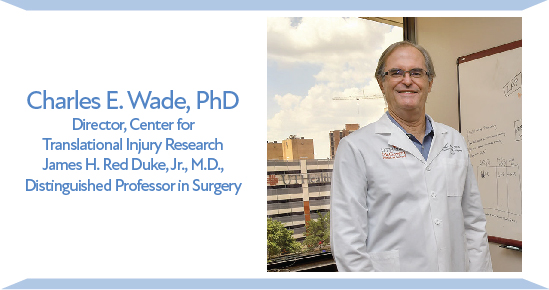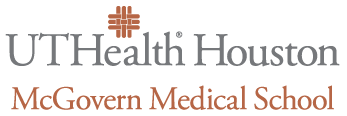August 12, 2020
 When did you join UTHealth? What brought you here? When did you join UTHealth? What brought you here?
I came to UTHealth in 2010 at the encouragement of Drs. Red Duke and John Holcomb. I had just retired from the government, where I was the senior scientist for combat casualty care assigned to the U.S. Army Institute for Surgical Research and Brook Army Medical Center in San Antonio. I was attracted to UTHealth as it is the largest trauma center in the United States with a faculty interested in optimizing patient outcomes by creating new approaches to treatments and care.
Tell us about your work history here.
I began my tenure as the Deputy Director of CeTIR – the Center for Translational Injury Research, a research entity that now reports to Dr. Andrassy. For the last three years, I have served as the director of CeTIR. The mission of the center is to lead in the research and development of the next-generation of medical technologies for the patient with traumatic injuries. When I arrived, we transitioned what we had learned in military-forward care into the civilian environment, focusing on the early control of bleeding. There is an interesting dynamic that takes place between wartime and peacetime in emergent care practices. In times of war there is an evolution of emergent care that subsequently transfers to civilian care. We made changes, such as the use of blood products earlier in the course of care, the use of tourniquets pre-hospital, and practicing damage-control surgery. Over the last 10 years, these practices have contributed to a reduction in the local mortality rate and improved outcomes. We are continuing to improve care and provide both basic and clinical data in support of the changes made.
How has the current pandemic affected your work?
Trauma is an endemic disease. It is the third-leading cause of mortality behind cancer and heart disease and the number one cause of death in those age one to 45. It is also a major cause of loss of quality of life. Traumatic injuries have not stopped during the COVID-19 pandemic. In fact, May and June have been the busiest two months ever.
What are you most proud of accomplishing?
I am proud of contributing to the development of a research culture that is driven by the requirements of care, and the resulting clinical care practices that are based on those basic and clinical research findings. I am proud to work with a faculty that is willing to, and takes pride in, putting data behind what they do clinically. All of our practice guidelines, with the clinical and basic science data supporting them, are available on the web for use. It is a matter of great pride to me that through these approaches, the UT trauma team is a leader in the improvements of care and treatment of the patient with traumatic injuries, both nationally and internationally.
Why have you stayed?
I stay because the work is challenging and rewarding. I enjoy the people I work with and the differences we are making. The faculty here is a unique group. In a lot of institutions, you get a hierarchical situation – but here there is a culture of willingness to change and improve. I think that culture a lot to do with our wide spectrum of interactions – from EMS, to Life Flight, to rehab, to neurosurgery, and orthopedics, every area that may touch the patient in their journey. We all work well together.
I enjoy supporting the young faculty who are developing a research career, be it in basic or clinical sciences, education, or management. There are medical students who come for summer research activities, and some stay on to earn master degrees. Young employees, who started as research assistants, have gone on to professional school. Individuals from both groups are now on the medical school faculty. Working with these young people is another reason for staying.
The large patient volume, compared to other institutions, is also an incentive to stay. I appreciate the patient diversity– there is not just one type of patient. We have varied ethnicities and cultures in Houston, which are not isolated to a particular socioeconomic group or medical condition. We have adequate numbers of patients for all types of studies. These factors make it an interesting and exciting population to study. When I wake up in the morning, I look forward to going to work.
How has this place changed since you first joined?
Two to three years ago, we saw a big increase in falls-from-standing; this was a result of an aging of the population. In the past, the average age of our patients was 39 years old, now it is at 45-46 years. The older population has resulted in an increase in co-morbidities that have necessitated changes in care, such as the means to control bleeding in the patient on anticoagulants. Recognizing the advancing age within the population and their unique problems has resulted in changes in some of the research activities.
What do you do when you are not working?
I like to read and cook in my free time. My wife and I use to have a house in Galveston, where we enjoyed coastal living on the weekends. We now have a home in France that we hope to get back to after COVID. We have five children and grandkids, spread out around the country, so visiting with them takes up non-work time.
|


 When did you join UTHealth? What brought you here?
When did you join UTHealth? What brought you here?